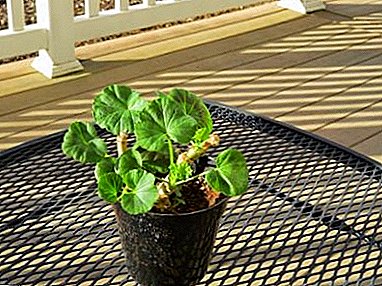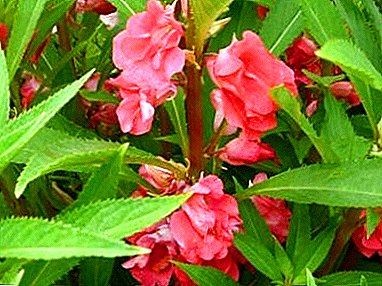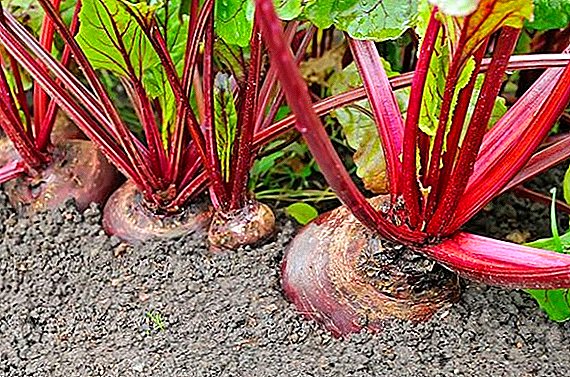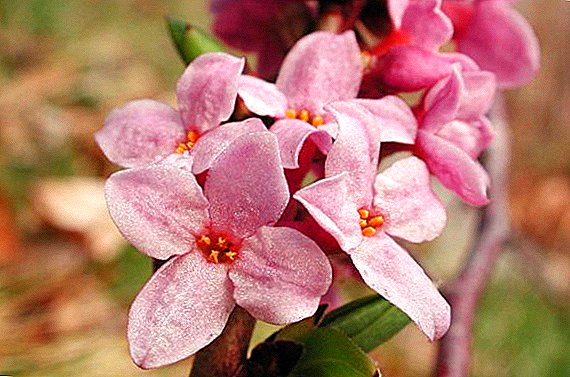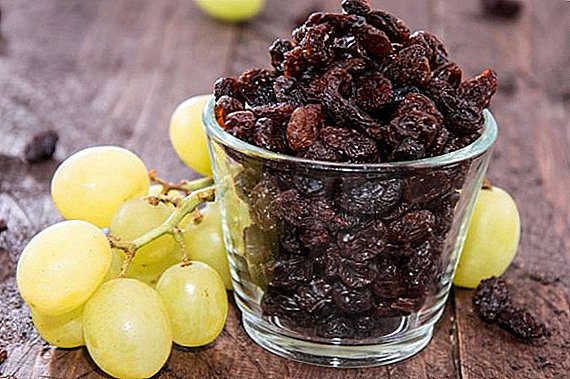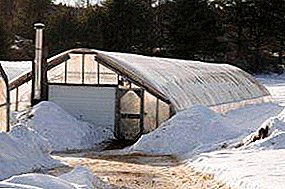
There are places on our planet where the climate allows you to collect two or even three crops a year. Of course, agriculture is thriving there and it turns out to be much more profitable than in our temperate latitudes, where plants have time to grow and give us fruits only once a year.
But there is a technology that allows to deceive nature and make the plant bear fruit all year round, even in winter, it is based on the use winter greenhouse, which you can build (do) with your own hands.
What are the advantages of a winter greenhouse?
The first - winter greenhouse, which you can build (make) with your own hands, gives possibility of perennial southern plants to develop normally for several years in a row (as seen in the photo). The fact is that many of the plants that grow only one season in our country are actually perennial. One of them is a tomato. This plant can grow up to three meters in height and bear fruit abundantly, like grapes.
The second advantage associated with the first. it opportunity to grow perennial tropical and subtropical plantsthat can not bear fruit in the first year of their life, like a tomato. So, in greenhouses they grow bananas, pineapples, lemons, kiwi and so on.

Fig.1 Banana palm in the greenhouse
Third - the ability to grow single or biennial plants, collecting harvest more than once a year. For example, you can get a crop of cucumbers or radishes for the New Year's table, grow carrots, radishes, beets and more. Lack of vitamins and fiber will not be throughout the year.
If there are enough greenhouse areas built by own hands, products can be sold in the winter time when the price of vegetables and fruits is maximum. Besides, fruits grown in Russia will have an important competitive advantage before imported: they do not have time to spoil themselves and there is no need to treat them from rot (imported vegetables and fruits are often covered with a layer of paraffin).
Fourth - such a greenhouse has the advantage of a purely technical nature: it is a capital structure is more durable, stable and durablethan ordinary greenhouses, greenhouses or covered beds. Such a structure necessarily has a foundation and will serve longer and less need to be repaired.
Mandatory Requirements
Of course winter greenhouse design for growing vegetables all year round with their own hands, must be different from the design of the greenhouse usual, especially from the construction of a covered bed or greenhouse.
Winter greenhouse must necessarily have a foundation. Besides its depth must be greater than the depth of soil freezing in the locality.
The frame of the winter greenhouse should be more durable, and consist of more reliable materials. This is especially true of the roof, because in the winter snow can fall on it, which sometimes accumulates to several tons.

Fig.2 Winter duo-pitch greenhouse
Cover material may also be different.. For the same reasons: the film can stretch and break through under a huge mass of snow. Especially dangerous for ice film, which is formed as a result of melting snow and its subsequent freezing. Glass in this sense is much better and safer. It should also be noted that one layer of covering material is not enough: such greenhouses are usually double layered. If the covering material is glass, then it is also a huge load on the frame.
How to make the winter greenhouse warm? A requirement is the presence in the greenhouse heating. Moreover, if the greenhouse has a greater length (more than 15 meters), you will most likely have to install not one stove, but two or even three.
And of course, the lighting. In winter, the plants will definitely suffer from a lack of light, especially in December, when short days overlap with cloudy weather. The design will have to provide space for light sources..
Preparatory work
Preparing for the construction of a winter (year-round) greenhouse do-it-yourself includes planning, preparing materials, preparing for installation of heating, and arranging the foundation.
Planning
There are many options for projects of winter greenhouses. They can be traditional, quadrangular in the top view, and there are hexagonal, can be different heights, be ventilated differently, etc. The easiest way to take project quadrangular (sometimes they say four-wall) greenhouses, and that's why:
- household plots and gardens usually have a quadrangular shape, arranging the greenhouse in the shape of the garden, you are rational use of space;
- four-wall construction greenhouses for winter growing simpler. Especially when glazing or stretching the film;
- for the maintenance of such a greenhouse, one single path can be made in the middle, along which irrigation pipes, etc. will be sent. That is, she easier to operate.
Six- (eight-, decimal) greenhouses usually have a modest size and the advantage that the hexagon has a more favorable ratio of area and perimeter, hence less heat loss, but the complexity of the design and the complexity of operation, the size limit makes such greenhouses a work of art rather than a means for making money or growing plants for food. Therefore, we consider the quadrangle greenhouse.

Fig.3. Hexagonal greenhouse
Oriented it should be from north to south, the roof is best done gable, and under the ridge of the roof install additional supportsso that the structure does not collapse under the weight of snow. If the frame is factory and the greenhouse in the section has the shape of an arch, it is even better - the snow itself will slide.
The place should be flat, the soil should be sandy.. If it is clay, you need to make a pillow of sand, and on top - a layer of fertile chernozem.
Ventilation should be carried out in the warm season regularlyotherwise the plants will die from the heat. So, you need to provide this feature in the design. First of allgreenhouse must have two doors at opposite ends, to get a draft at their simultaneous opening. Secondlyif the greenhouse has more than 10 meters in length, it is desirable that it also had opening windows. Windows can be in the side walls, the ceiling, next to or above the doors. The higher the windows, the better.
Materials
Here the stronger the better. Best steel corner or pipe. Suitable galvanized iron frame. Bolt on.
Worse - timber, board or pole. It is better to fasten a tree with screws; nails are often pulled out by the wind, especially when the tree begins to collapse.
Non-galvanized iron is desirable to paintso that it is less rusted, wood - process with antisepticso that fungi or insects do not start.
Foundation device
This mandatory part of the winter greenhouse should reach a depth where the earth no longer freezes through. The foundation may consist of a cinder block or concrete. Above it should be always insulated with waterproof material (tol) so that the moisture does not rise above.
The foundation should be on the foundationwhich is built from the same cinder block or brick. At the same time greenhouse floor may be below the level of the surrounding soil, ie, year-round greenhouses, made with their own hands, as if dug into the ground for better heat preservation.
Heating preparation
For large greenhouses the best heating is wateras in the house. It will evenly distribute heat. But it requires a lot of money, materials and labor, because it will be easier to make some ordinary burzhuek. To potbelly stove was more effective, the pipe from it should not go straight up. Instead of this make 5 meters of pipe at a slight slope (up to 10 degrees), and then connect with a vertical pipe.
Be careful that there are no smoke leaks in the joints - it is destructive for plants, since it contains sulfur oxides.

Fig.4. Example of heating in a winter greenhouse
Also exist infrared burners on gaswhich will serve as an additional source of heat. But they need to be shielded from the ceiling and from plants. It is best to place such a burner inside a large pipe that is open on both sides. Natural gas combustion products for plants are almost harmless., unlike the products of combustion of wood and coal.
We build a greenhouse step by step
How to build (make) a greenhouse for winter growing (warm, year-round or winter) with your own hands? So, in order:
- Explore the terrain.
- Think over the device of the winter (all-the-year-round) greenhouse - sketch out a preliminary draft (drawings, diagrams of the future structure, which you will do with your own hands).
- Prepare (buy) materials.
- Modify the project if it is necessary due to the absence or presence of certain materials.
- Mark up the place for the greenhouse and dig a trench for the foundation.
- We make concrete and fill it in a trench (formwork from boards or fittings can be used, but not necessarily).
- We waterproof the resulting foundation with roofing material.
- We build on the base of red or white brick, or of the same concrete.
- Putting the frame. Side racks of the frame can be attached to the base in different ways, depending on what materials are used. It can be anchor if you need to fix the tree to the concrete. If the metal is attached to a brick, you can simply leave space in the basement, and after the racks are installed, pour them with concrete.
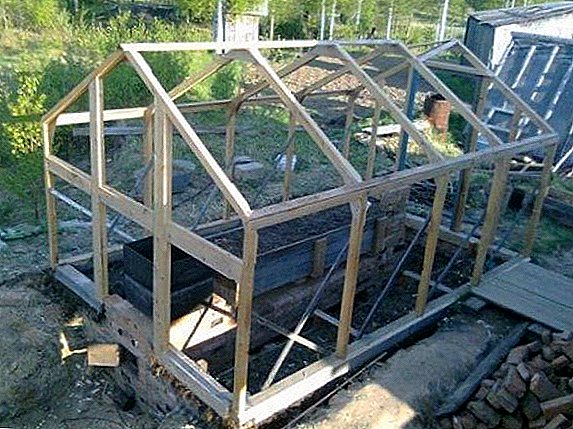
Fig.5 Framework during assembly
- When the frame is ready, time to think about heating. Install stoves and chimneys. In the right places of the frame it is necessary to make an outlet for the chimney. It is a square of tin or plywood with a hole in the center to the size of the pipe. Need this, so that the hot pipe does not come into contact with covering materialwhen the greenhouse is covered.
- Prepare places for lighting. The simplest - suspended fluorescent lights. They need hooks attached to the frame on which they will hang. Particularly inventing with wiring is not necessary - you can use an ordinary extension cord and socket in the nearest electrified building.
- We shelter the greenhouse. Under the glass need special grooves in the frame and putty to get rid of the cracks. The film is nailed with thin rails. Polycarbonate is fixed with bolts or screws using large thermal washers. The holes for the pipes should remain uncovered (if you stretch the film in one piece, the future hole should be upholstered around with wooden slats and then cut through. The covering material should not touch the pipe in any case..
- We install vertical chimneys in the prepared places for them.
- We hang fluorescent lamps.
Thus, the greenhouse is ready to use. Then it will be possible to drip irrigation into it, automatic systems of switching on / off the light, etc., but this is no longer necessary.

Fig.6 An example of the construction of a thermo-greenhouse with a hand dug in
Conclusion
Thus, winter greenhouses for year-round cultivation, built with their own hands, are more capital construction in comparison with ordinary greenhouses, require a lot of time and laborbut allow you to grow exotic plants even in the harsh climate of the temperate zone, as you can see from the descriptions and photos of this article. it will recoup the cost of their construction for several years.



